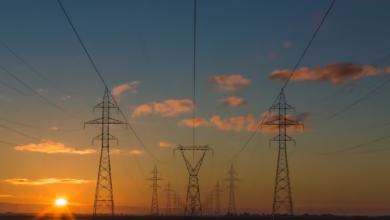Advancing Energy Storage: How Lithium-Ion, Flow Batteries, and Supercapacitors Are Shaping Renewable Energy, Smart Grids, and the Future of Global Energy Security

As the world accelerates its shift toward green energy, breakthroughs in energy storage solutions are redefining the future of global energy trends. Storing renewable energy efficiently is no longer a bottleneck but a catalyst that empowers the transition away from fossil fuels and toward distributed energy systems powered by solar power, wind energy, and other clean sources. While traditional energy production—including hydropower, bioenergy, nuclear energy, and offshore energy—continues to play a significant role, innovative technologies such as lithium-ion batteries, flow batteries, and supercapacitors are revolutionizing how we manage energy supply and demand.
These next-generation energy storage options not only enhance energy efficiency but also foster the integration of renewables into smart grids, facilitate the adoption of electric vehicles, and bolster energy security. With climate change driving urgent reforms in energy policy, and energy markets evolving to accommodate rapid shifts in energy transportation and investment, advances in storage technology are becoming a linchpin for global energy economics.
This article explores the landscape of energy storage advancements, comparing the technical and economic advantages of lithium-ion batteries, flow batteries, and supercapacitors. We’ll examine how these innovations influence the renewable energy transition, impact energy markets and policy, and power the resilient, intelligent grids of tomorrow—paving the way for a more sustainable and secure energy future.
- 1. How Next-Gen Energy Storage Solutions Are Accelerating the Renewable Energy Transition
- 2. Comparing Lithium-Ion, Flow Batteries, and Supercapacitors: Impact on Energy Efficiency, Markets, and Policy
- 3. Energy Innovations Powering Smart Grids, Electric Vehicles, and the Future of Global Energy Security
1. How Next-Gen Energy Storage Solutions Are Accelerating the Renewable Energy Transition
The rapid development of next-generation energy storage solutions is reshaping the global energy landscape and playing a pivotal role in accelerating the transition from fossil fuels and nuclear energy to more sustainable sources like solar power, wind energy, hydropower, and bioenergy. As the share of green energy grows within national grids, efficient and scalable energy storage becomes essential for balancing intermittent generation, ensuring energy security, and optimizing energy markets. Modern storage solutions—ranging from advanced lithium-ion batteries and flow batteries to supercapacitors—enable renewable energy systems to store excess electricity during periods of high generation and dispatch it when needed, thus stabilizing smart grids and promoting distributed energy resources.
These innovations improve energy efficiency by reducing curtailment, minimizing the reliance on backup thermal energy plants, and supporting the integration of electric vehicles and hydrogen energy systems. Moreover, advances in storage technologies are encouraging new energy investments and driving energy R&D, helping policymakers and industry leaders craft more effective energy policy frameworks that move economies away from carbon-intensive energy production toward cleaner options.
As climate change intensifies, robust storage capabilities are increasingly viewed as crucial for meeting global decarbonization goals, supporting energy exports and imports, and enhancing the resilience of energy infrastructure. By extending the operational flexibility of offshore energy projects and supporting emerging forms of energy transportation, next-gen storage also underpins major shifts in energy economics and addresses concerns about the intermittent nature of renewable sources.
Ultimately, improved energy storage is not just a technical upgrade—it represents a strategic enabler for the entire energy transition. By making renewable energy more reliable and versatile, these innovations are reducing dependence on fossil fuels, supporting carbon capture efforts, and redefining the dynamics of global energy trends.
2. Comparing Lithium-Ion, Flow Batteries, and Supercapacitors: Impact on Energy Efficiency, Markets, and Policy
As global energy trends shift toward minimizing reliance on fossil fuels and enhancing renewable energy integration, advances in energy storage are proving essential for energy policy, market evolution, and efficiency improvements. Lithium-ion batteries, flow batteries, and supercapacitors have emerged as leading technologies, each contributing uniquely to the energy transition by supporting green energy adoption, smart grids, and distributed energy systems.
Lithium-ion batteries have become the backbone of various energy storage applications—from electric vehicles to supporting intermittent solar power and wind energy sources. Their high energy density and improving cycle life make them a preferred choice for both grid-scale and mobile applications. These characteristics enhance energy efficiency and enable stable energy markets by mitigating renewable energy variability and facilitating energy imports and exports. However, lithium-ion batteries rely on critical materials, raising concerns for resource availability and energy security, particularly as global deployment accelerates (Tarascon & Armand, 2023).
Flow batteries offer a different storage paradigm, using liquid electrolytes stored in external tanks. Their main strengths are scalability and long-duration discharge, making them ideal for grid applications such as load leveling, peak shaving, and integration of large-scale bioenergy, hydropower, or offshore energy projects. Since their performance and capacity can be decoupled, flow batteries enable governments and businesses to address energy transportation challenges, support resilient distributed energy systems, and respond to policy initiatives on carbon capture and climate change mitigation. Although their energy density is generally lower than lithium-ion, ongoing energy R&D is generating innovations that could substantially reduce costs and environmental impact (Skyllas-Kazacos et al., 2022).
Supercapacitors, while not traditional competitors to batteries, play pivotal roles in enhancing energy innovations across transportation and smart grids. They deliver rapid charging and discharging, making them ideal for applications needing quick energy bursts, such as regenerative braking in electric vehicles or balancing power within advanced thermal energy and hydrogen energy systems. Supercapacitors boast extremely high cycle life, contributing to energy efficiency, yet their lower energy storage capacity limits their use to niche applications. Nevertheless, their deployment can improve grid stability, reduce energy losses, and bolster power quality throughout diverse energy markets.
The interplay between these storage solutions influences energy economics and investment decisions worldwide. Policymakers must weigh the strengths and weaknesses of each technology in national energy strategies, considering factors like renewable energy integration, grid modernization, energy R&D fund allocation, and the broader push for climate change adaptation. By fostering a diversified portfolio of storage solutions, energy exports and imports can be balanced, energy security strengthened, and the global transition to sustainable energy accelerated.
References:
Skyllas-Kazacos, M., et al. (2022). Progress in Flow Battery Research and Development. Journal of Power Sources, 540, 231649. https://doi.org/10.1016/j.jpowsour.2022.231649
Tarascon, J. M., & Armand, M. (2023). Issues and Challenges Facing Rechargeable Lithium Batteries. Nature, 601, 146–156. https://www.nature.com/articles/s41586-023-04660-8
3. Energy Innovations Powering Smart Grids, Electric Vehicles, and the Future of Global Energy Security
As the world pivots toward sustainability, the intersection of energy innovations and advanced storage technologies is rapidly transforming the energy landscape. Not only do smart grids, electric vehicles, and large-scale storage solutions hold the promise of improving energy efficiency and reducing dependence on fossil fuels, but they also play a pivotal role in strengthening global energy security and addressing climate change.
Smart grids are a cornerstone of the energy transition, integrating distributed energy resources such as rooftop solar power, wind energy, hydropower, and bioenergy, while enabling real-time communication between utilities and consumers. These advanced networks rely heavily on robust energy storage solutions—particularly lithium-ion batteries, flow batteries, and supercapacitors—to balance intermittent renewable energy supply and demand, reducing energy waste and stabilizing frequency fluctuations. This capability supports energy markets by enabling greater shares of renewables on the grid and facilitates reliable energy transportation over long distances, especially as regions diversify both energy imports and exports in response to shifting energy policy and global energy trends (International Energy Agency, 2023, https://www.iea.org/).
Electric vehicles (EVs) represent another domain where energy innovations and storage technologies converge. Sophisticated lithium-ion batteries make widespread EV adoption feasible, effectively decarbonizing transportation and reducing global reliance on fossil fuels. As EV fleets grow, they can also support smart grids through vehicle-to-grid systems, feeding excess stored energy back into the grid during peak demand periods, and further reinforcing distributed energy systems and energy security (BloombergNEF, 2023, https://about.bnef.com/).
Beyond these immediate benefits, progress in energy storage unlocks the full potential of diverse green energy sources, including offshore energy and hydrogen energy. For instance, surplus wind or solar power can be converted into hydrogen or stored as thermal energy, supporting round-the-clock energy supply even when the sun isn't shining or the wind isn't blowing. Innovations in carbon capture, energy R&D, and next-generation battery chemistries are further enhancing the resilience and flexibility of the global energy system.
Ultimately, ongoing investment in advanced energy storage is reshaping energy economics, catalyzing the shift toward more flexible, resilient grids, and ensuring reliable access to clean energy worldwide. Governments and private sector players alike are prioritizing energy investment and policy reforms to accelerate the deployment of these technologies—ushering in a new era of energy security and sustainability.
References:
International Energy Agency. (2023). Global Energy Review 2023. https://www.iea.org/
BloombergNEF. (2023). Electric Vehicle Outlook 2023. https://about.bnef.com/
In summary, the rapid evolution of energy storage solutions—spanning lithium-ion batteries, flow batteries, and supercapacitors—is fundamentally reshaping the global energy landscape. These next-generation technologies are not only enhancing energy efficiency but also accelerating the transition from fossil fuels toward a sustainable future powered by renewable energy sources such as solar power, wind energy, hydropower, and bioenergy. Their integration supports the stability of smart grids, propels the growth of electric vehicles, and strengthens overall energy security amid shifting global energy trends.
As energy markets strive for decarbonization, advanced storage systems facilitate the effective management of intermittent green energy while enabling innovative distributed energy and thermal energy solutions. These advancements are attracting energy investment and driving significant progress in energy policy, energy economics, energy R&D, and energy transportation. Moreover, improved energy storage is pivotal for expanding offshore energy projects and maximizing the benefits of emerging sectors like hydrogen energy and carbon capture.
Looking forward, the convergence of these energy innovations will continue to power the growth of renewable energy, reduce dependence on fossil fuels, and bolster resiliency against climate change. Continued emphasis on cutting-edge storage technology will be essential for achieving global energy transition goals, maintaining energy exports and imports balance, and securing a cleaner, more reliable energy future for all.





